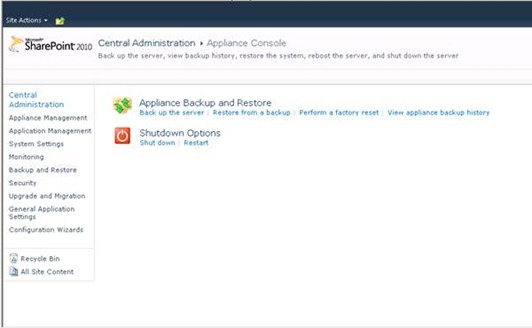HP Business Decision Appliance – A Closer Look at Backup and Availability Features
Today we announced the availability of the HP Business Decision Appliance. This is the culmination of many months of engineering work between HP and Microsoft to develop a software/hardware solution to enable easy access to self-service business intelligence technology. The solution is designed for medium size businesses and departmental enterprise deployments.
The appliance is optimized for Windows Server 2008 R2, SQL Server 2008 R2, SharePoint 2010 and PowerPivot for SharePoint. One of our goals was for a simplified installation and configuration. Talking with customers, we found that for some businesses, deploying the above software stack took many months and required outside experts. We created a single installation program that prompts the users for a small set of questions and then installs and configures SharePoint, SQL Server and PowerPivot. From power up to a running SharePoint server takes about an hour in most cases.
I wanted to share with you a few items you might not have picked up from the announcements. The appliance installs SharePoint 2010 and PowerPivot for SharePoint as a Single Server Farm Installation. That means that the appliance is completely self-contained. SQL Server and all the SharePoint services are installed on this single appliance. The only external software requirement is that the customer has an Active Directory domain available. The appliance is joined to the domain as part of the appliance installation.
Because the solution is self-contained, we designed a good deal of redundancy into the appliance. The hardware has dual-power supplies, dual fans and multiple gigabit network cards. There are 8 SAS 300GB hard disks. Two of them are used for a mirrored system disk that contains the operating system and the recovery partition. The other 6 hard disks are configured in a RAID 5 array where the data and backup partitions are located. This disk configuration allows the appliance to survive a physical disk failure.
The appliance also has built-in backup and recovery capabilities. An Appliance Management Console is added to the SharePoint Central Administration during installation. In the Appliance Management Console, you will find options to backup the appliance and perform a factory reset. The appliance backup image uses Windows Server Backup to capture a complete image of the running server. Backups are stored in the Backup partition. Windows Backup can store multiple backups on the partition and will overwrite the older backup images when space is needed for the current backup. The Appliance Management Console also has a screen that allows you to view the appliance backup history.
NOTE: The onboard backup is meant as an interim backup solution. As your needs grow, you should consider moving to network backup storage or using a product like System Center Data Protection Manager, which has features to backup Windows Server 2008, SharePoint 2010, and SQL Server 2008 R2.
Factory reset lets you re-image the appliance back to the factory state. The appliance is returned to the state it was in when leaving the manufacturer. This re-initializes all of the hard drives and extracts and configures the boot image onto the disks. This allows you to re-image the box if you make a mistake or want to restart the configuration from the original state.
NOTE: Yes, it’s cool, but be careful with Factory Reset if you have used the onboard backup capabilities! Factory Reset re-initializes all drives, which means it will erase any backups that you have done previously to the backup partition.
A screenshot of the Appliance Management Console is shown below:
As you can see, the appliance has a good deal of availably features right out of the box. In future posts I will cover additional features we added to the appliance and provide insight into some of the configuration changes we make to optimize the software running on the appliance.
Learn more about the HP Business Decision Appliance here.
Dana Kaufman
Principle Program Manager
SQL Server Appliance Engineering Team
Twitter: www.twitter.com/dskaufman1


